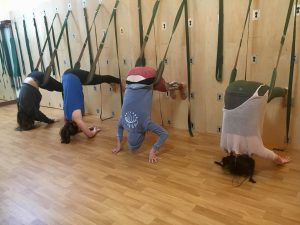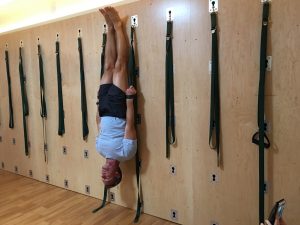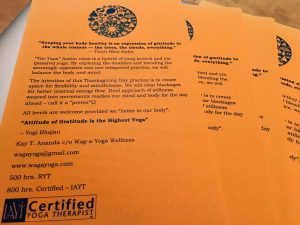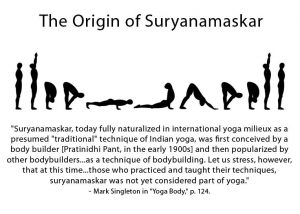As a yoga teacher and therapist, I’d love to explain what each yoga style is all about and yes, ask me. Sometimes, the class may be titled very general such as “Hatha Yoga” or “Yoga for Back Care” – so what does that title really mean and what kind of practice would that be? Who would benefit most from one style to the other and … why are there so many different branches and styles of yoga? Short of history or the roots talk, I found this article to be simple and short at explaining some of the major styles of yoga you often hear about – and of course your local yoga studio should be able to define each class they offer more clearly:
Just hanging out …dangling, spine elongated just by giving into gravity …
Great Wall Yoga is super yummy for back care and those none gymnasts, dancer, not even athletic- back ground, regular folks who want to stay fit mentally spiritually and physically – say goodbye to lower back compression; relieve neck/shoulder stiffness – plus the benefits of an inversion – although these props have been used in Iyengar yoga from inception … so to have it here is a … wow. What if I had curated music (No Coldplay – for my past post referencing, click HERE ) and blended the wall practice with flowy mat practice … Mix the Styles … What might that look like and what might that be called ? Yoga for Creativity:) ?? With something like 20+ hrs training, had to think about how to incorporate the wall part with none-wall part … recalling how at Iyengar studio I used to go to, some students just went off on their own to use the wall. They knew what they needed and how to modify a pose to fit their needs. Interesting. It’s that safe container of adult playground:) Same goes for all props … some know exactly what they are doing and some using props for the first time … so fun to see how we explore and discover something about our own body each time. Letting go of our ego, just tending to our body-temple:)
Yoga could be thousands of years old, as is traditional martial arts, sure, but needs of our ancestors from waaay back then might have been vastly different than our needs today … while the underlying human struggles and suffering remain the same: we get sick; we get hurt; we experience loss; we will all die and no one is exempt (did I depress everyone?), it is what it is – or is it? Yoga allows you to question – if there’s another way.
So while the basics of humanness remain the same … back at the early stages of yoga practices, there may not have been any of all this sitting around, hours on chairs looking at screens …there were no processed foods; there were no …. (fill in the blanks); and in return we have today all these modern conveniences and medical advances … would the practice that served our ancestors serve our needs the same way today?
So today’s yoga is the evolution of all that has come before us. It keeps changing while the basic philosophy and tenets remain rock solid. It’s up to us to find and develop a practice that’s suitable to our own unique body bone structure, our own needs reflecting our age and condition … our own intention for getting on this mat today. Challenging ourselves help us grow but when what we are looking for is healing at every level, the practice starts to look a little different.
Yoga Therapeutics is not a “style” of yoga:
“Yoga therapy is the process of empowering
individuals to progress toward improved
health and wellbeing through the application
of the teachings and practices of yoga.
Yoga is a scientific system of self-investigation,self-transformation,and self-realization
that originated in India.
The teachings of yoga are rooted in the Vedas and grounded in classical texts and a rich oral tradition.This tradition recognizes that the human being’s essential
nature is unchanging awareness that exists
in relationship to and identification with the
changing phenomena of the empirical world.
The yoga tradition views humans as a multidimensional
system that includes all aspects of body; breath; and mind, intellect, and emotions and their mutual interaction.
Yoga is founded on the basic principle that intelligent practice can positively influence the direction of
change within these human dimensions, which
are distinct from an individual’s unchanging
nature or spirit.The practices of yoga traditionally
include, but are not limited to, asana,
pranayama, meditation, mantra, chanting,
mudra, ritual, and a disciplined lifestyle.
Yoga therapy is the appropriate application of
these teachings and practices in a therapeutic
context in order to support a consistent yoga
practice that will increase self-awareness and
engage the client/student’s energy in the direction
of desired goals.”
– excerpt from IAYT publication
You can find a certified yoga therapist at this site: Here:)
Fully supported inversion where you feel …weightless … thanks to Jason Cull, Yoga Therapist, Yoga Wall TT teacher 🙂 Humble and yet thorough in his teachings … a yogi that he is.
My flyer for the Thanksgiving class …
Subbing for beautiful Lorraine tomorrow night – Pure Yin:) I love Vinyasa as that’s my practice, the core; but Yin is my roots:) Thank you for the opportunity.
Hoping to practice more in 2019 at the Great Wall of Yoga with guidance of Iyengar Yoga Institute certified teacher, the magnificent Maria @
Yoga Health Center@ 677 Laurel St #200, San Carlos



